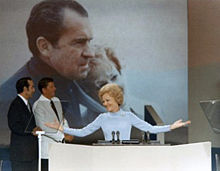1972 Republican National Convention
| 1972 presidential election | |
  Nominees Nixon and Agnew | |
| Convention | |
|---|---|
| Date(s) | August 21 - August 23 |
| City | Miami Beach, Florida |
| Venue | Miami Beach Convention Center |
| Candidates | |
| Presidential nominee | Richard Nixon of California |
| Vice-presidential nominee | Spiro Agnew of Maryland |
The 1972 National Convention of the Republican Party of the United States was held from August 21 to August 23, 1972 at the Miami Beach Convention Center in Miami Beach, Florida. It nominated the incumbents Richard M. Nixon of California for President and Spiro T. Agnew of Maryland for Vice President. The convention was chaired by then-U.S. House Minority Leader and future Nixon successor Gerald Ford of Michigan. It was the fifth time Nixon had been nominated on the Republican ticket as either president or vice-president, matching Nixon with Franklin Roosevelt, who was also nominated on five tickets as a Democrat.
Site Selection
San Diego, California, had originally been selected as host city for the convention. Columnist Jack Anderson, however, discovered a memo written by Dita Beard, a lobbyist for International Telephone and Telegraph, suggesting the company pledge $400,000 toward the San Diego bid in return for the U.S. Department of Justice settling its antitrust case against ITT.[1] Fearing scandal, and citing labor and cost concerns, the GOP transferred the event—scarcely three months before it was to begin—to Miami Beach, which was also hosting the 1972 Democratic National Convention. It was the third and last time both the Republican and Democratic national party conventions were held in the same city.[citation needed] The RNC did not return to San Diego until 1996.
Speeches
The convention set a new standard, as it was scripted as a media event to an unprecedented degree.[2]
The keynote address, by Anne Armstrong of Texas, was the first national convention keynote delivered by a woman.[3]

First Lady Pat Nixon became the first Republican First Lady, and the first First lady in over 25 years, to address a party's national convention. Her speech set the standard for future convention speeches by political spouses. First Ladies Nancy Reagan, Barbara Bush, and Laura Bush, among others, have all followed in this tradition.
The balloting
Nixon easily turned back primary challenges on the right from Rep. John M. Ashbrook of Ohio and on the left from Rep. Pete McCloskey of California. However, under New Mexico state law, McCloskey had earned one delegate, which the convention refused to seat, fearing that the delegate might put McCloskey's name in nomination and give an antiwar speech. U.S. Representative (and delegate) Manuel Lujan of New Mexico, a staunch Nixon supporter, decided to honor state law by voting for McCloskey himself. The final result was that Nixon received 1,347 votes to one for McCloskey and none for Ashbrook. Throughout the precisely scripted convention, delegates chanted "Four more years! Four more years!"[4]
Spiro Agnew was re-nominated for vice president with 1,345 votes, against one vote for television journalist David Brinkley and two abstentions.[citation needed] The NBC network, for which Brinkley worked, had some "Brinkley for Vice President" buttons made, which the news team wore as a joke.[citation needed]
Protest activity
The convention was targeted for widespread protests, particularly against the Vietnam War, and the Nixon administration made efforts to suppress it. In 2005, files released under a Freedom of Information Act lawsuit showed that the Federal Bureau of Investigation even monitored Beatle John Lennon after he was invited to play for Yippie protests. The monitoring of Lennon later concluded that he was not a dangerous revolutionary, being "constantly under the influence of narcotics."[citation needed]
The U.S. Justice Department indicted Scott Camil, John Kniffen, Alton Foss, Donald Perdue, William Patterson, Stan Michelsen, Peter Mahoney and John Briggs—collectively known as the Gainesville Eight—on charges of conspiracy to disrupt the Convention. All were exonerated.
In his autobiography, Born on the Fourth of July, Ron Kovic describes how he and fellow Vietnam Veterans Against the War protesters Bobby Muller, Bill Wieman, and Mark Clevinger were spat upon at the convention.[5]This incident is also depicted in the 1989 Oliver Stone film Born on the Fourth of July, based on Kovic's autobiography of the same name.
See also
References
- ^ When the Elephants Marched Out of San Diego | San Diego History Center
- ^ http://web.archive.org/web/20060209223353/http://www.findarticles.com/p/articles/mi_m2519/is_6_25/ai_n6142582. Archived from the original on February 9, 2006.
{{cite news}}: Missing or empty|title=(help); Unknown parameter|deadurl=ignored (|url-status=suggested) (help) - ^ Holley, Joe (July 31, 2008). "Leading Texas Republican Anne Armstrong". The Washington Post. Retrieved April 20, 2010.
- ^ "A New Majority for Four More Years?". TIME. 1972-09-04.
- ^ JustOneMinute: Who Spat On Whom?
- Ancona, Vincent S. When the Elephants Marched Out of San Diego: The 1972 Republican Convention Fiasco, The Journal of San Diego History, Fall 1992, Volume 38, Number 4
- "Lennon 'too stoned to pose threat'," September 22, 2005, retrieved from CNN.com December 14, 2005.
- Kirkpatrick, Jeane J, "Representation in the American National Conventions: The Case of 1972," British Journal of Political Science, July 1, 1975. Available as a PDF courtesy of the American Enterprise Institute
External links
- Nixon, Richard "Remarks on Accepting the Presidential Nomination of the Republican National Convention," August 23, 1972. Provided by the American Presidency Project, University of California, Santa Barbara.
- Four More Years, TVTV Documentary MediaBurn.org: Video Preview
| Preceded by 1968 Miami Beach, Florida |
Republican National Conventions | Succeeded by 1976 Kansas City, Missouri |
